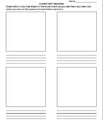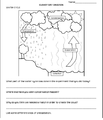Cloudy Day Creation
| Instant wiki maker | Making handouts | Editing tips |
Contents
- 1 Student worthiness
- 2 Primary scientific content area covered
- 3 Materials
- 4 Handouts
- 5 Description of activity
- 6 Lesson plan
- 7 Experiment In Action
- 8 Potential pitfalls
- 9 Math connections
- 10 Literature connections
- 11 Connections to educational standards
- 12 Next steps
- 13 Reflections
- 14 Citations and links
Biology In Elementary Schools is a Saint Michael's College student project from a course that ran between 2007 and 2010 and fully described in this book chapter. The student-created resources have been preserved here for posterity. Link under 'toolbox' for printer-friendly versions of the exercises. Click on handouts to print full resolution versions. Please see Wikieducator's disclaimer, our safety statement, and the Creative Commons licensing in English and in legalese.
Student worthiness
This experiment has been tested by the teachers on their own. It has also been tested with students and worked very well. Versions of this experiment have been recommended online.
Primary scientific content area covered
In this experiment students will create their own cloud. Cloud formation occurs when warm, humid air rises and cools, causing the water vapor in the air to condense and form water droplets which become clouds. In order for clouds to form the tiny droplets of water need to be able to cling on to something at just the right temperature. They can cling to particles like dust, salt, or smoke. Dust particles in the air form nuclei to accelerate cloud formation.
The process of condensation is when water vapor in the air turns into liquid water. It is responsible for the formation of clouds. The clouds can create precipitation, which is how the water returns to the Earth's surface in the water cycle. Condensation is the opposite of evaporation. Clouds involve the process of evaporation because clouds are made up water gone though condensation. The tiny droplets in liquid form that they are made of evaporate, this is when cloud cover dissipates due to evaporation.
Students will also be asked to apply the concept of observation and hypothesis from the scientific method. This experiment helps students understand parts of the water cycle specifically evaporation and condensation by observing these processes on a small scale in a jar.
Materials
Materials Required for the Teacher
- Matches
Materials Required for Each Student Group
- Gallon Glass Jar
- Ice (in a bag)
- Water (warm water)
- Food Coloring
- Flashlight
- Black Paper
- Materials
Materials Required for Each Student
- Writing Utensil
- Worksheet/ Handout
- Excitement
Handouts
Below are the handouts given to each student. They fill the observation sheet out first, while the experiment is going on and the information sheet after the experiment has finished.
PDF VERSIONS:
Observation Handout
Water Cycle & Additional Questions Handout
Description of activity
This activity creates a cloud in a jar. Cloud formation results when warm, humid air rises and cools, causing the water vapor in the air to condense and form clouds. Students will create their own cloud in a jar and try to explain what happened. They will put warm water in a jar with food coloring. Then the teacher will light a match and then drop it into the jar. When the match lights, the smoke fills the bottle, the smoke then disappears but the invisible particles still float around in the bottle. A student will quickly put the bag of ice on top of the jar. This will result in a cloud formation inside of the jar. They can see this cloud better by shining a flashlight and having black paper on one side of the jar.
Lesson plan
20 Minute Lesson Plan Geared for 3rd Grade Students
First 5 Minutes:
- Ask students how they believe clouds are formed. They can write their answers down at the top of their observation sheets. You can engage them by asking why on a cold day can we see our breath. The answer is that the air we exhale contains moisture in the form of water vapor. When that warm, moist air meets the cold, dry air outside, a cloud forms.
Next 8 Minutes:
- Tell the students that we are going to perform a simulation of the forming of a cloud. Take out the jar and have one of the students tape the black piece of paper onto one side of the jar. Ask another student to pour the warm water into the jar until it is one third full. Add the food coloring and put the cap on to shake the bottle.
- Then the teacher will light a match and hold it at the top of the jar for a few seconds and then drop it in. At this point, have a student quickly cover the jar with the bag of ice.
- Have another student shine the flashlight on the jar while they record their observations.
Last 7 Minutes:
- Go over the recorded observations, what happened?
- Explain how clouds are formed.
- Explain the water cycle through use of the handout and sing the water cycle song.
(Sang to the tune of She'll Be Coming Around the Mountain)
Water travels in a cycle, yes it does Water travels in a cycle, yes it does It goes up as evaporation Forms clouds as condensation Then comes down as precipitation, yes it does!
- Clean up any materials necessary.
Experiment In Action
- Experiment in Action
<kaltura-widget kalturaid='0_jcd21nty' size='L' align='C'/>
Potential pitfalls
This activity will work best with small groups so that all students can see the cloud formation. Students should not handle the matches for safety reasons, they may be attracted by the fire but they must not handle the matches. The students should also be careful with the glass jars. There could be potential problems if the ice is not put on top of the jar quickly enough. The water also must be warm for this experiment to go correctly. Clouds may not form if the directions are not followed carefully. We also realized it is easier to see the cloud if the lights are off and the flashlight is essential. The closer you bring the flashlight to the jar the better you can see the cloud.
Math connections
One possible math activity that could be used as an extension could involve students recording the clouds they see for a week. They could graph how many days they saw each type of cloud. They could then present their graphs to the class and compare with each other.
Literature connections
Some books involving clouds are:
- The Magic School Bus Kicks Up A Storm: A Book About Weather By Nancy White
- The Cloud Book by Tommie DePaola
- Cloud Boy by Rhode Montijo
- Cloudy With a Chance of Meatballs by Judi Barrett and Ron Barrett
You could have the students read these books prior to this lesson if they were doing a unit on the weather. These books can also be used to explain how clouds are formed and give them a better idea through pictures and writing. They will be engaged by the pictures and fun story lines which will allow them to become more interested in cloud formation. (The citations of these books can be found in the citation section).
Connections to educational standards
- 7.3.b. Look for evidence that explains why things happen.
- 7.3.c. Modify explanations when new observations are made or new knowledge is gained.
- 7.12.c. Observe and describe the behavior of gases in containers (e.g., pumps, balloons).
- S3-4:48 “Describing water as it changes into vapor in the air and reappears as a liquid when it is cooled” AND “Explaining how this cycle of water relates to weather and the formation of clouds”.
- S3-4:48 "Students demonstrate their understanding of Processe and Change over Time within Earth Systems by
d. Clouds and fog are made of small drops of water.
Next steps
Using the materials used in this experiment there are plenty other ways to show the aspects of the water cycle. This specific experiment incorporated precipitation, condensation, and evaporation. Boiling water and showing the students the process of water circulating into air would be a very easy way to show water molecules and water movement. When it is snowing or raining outside that is another real life example of the different aspects of the water cycle.
The students really seemed intrigued by this type of activity and as long as there are opportunities for students to get hands on they will be quite engaged!
Reflections
After doing this experiment it was clear how much the students enjoyed the activity! One thing that was crucial to the experiment was having the black background on the jar. This allowed the students to see the cloud forming and with the reflection of the flashlight it made the whole experiment much better. This activity it pretty straight forward so it went quite smoothly. We didn't have any complications while running the experiment but the only suggestion would be to have the bag of ice sitting in a bucket while not being used just in case it begins to melt.
Prior to doing this activity with students I would suggest that they have some of the basic vocabulary of the water cycle down. This would include having some basic understanding of precipitation, evaporation, condensation and knowing where these aspects can be found in everyday life. The students we worked with were familiar with the water cycle which helped in our experiment. Also knowing how a cloud is formed could also be very helpful to working with students. Helping them by giving examples of cloud formation in everyday life, like breath on a cold day, and condensation in the shower helps students apply it to their daily life. Most of the students had the basic understanding of all these aspects and it made the experiment run easier and I think it helped them engage more with what we were doing.
The students loved singing the song about the water cycle. It is great to add interdisciplinary aspects into any lesson and this song is a fun way to incorporate music, and literature. If you decide to dye the water as we did I would suggest to allow each student participate in dropping the specified color into the water. The more you allow the students to get involved the happier and more excited they will be to learn what is being demonstrated!
Citations and links
- Barrett, Judi, and Ron Barrett. Cloudy with a Chance of Meatballs. New York: Atheneum, 1978.
- DePaola, Tomie. The Cloud Book: Words and Pictures. New York: Holiday House, 1975.
- Montijo, Rhode. Cloud Boy. New York: Simon & Schuster for Young Readers, 2006.
- White, Nancy, Art Ruiz, Joanna Cole, and Bruce Degen. Scholastic's The Magic School Bus Kicks up a Storm: a Book about Weather. New York: Scholastic, 2000.








